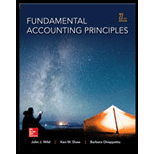
Concept Introduction:
Acid test ratio: Acid test ration is also called Quick ratio. This ratio is calculated by dividing the quick assets (Cash, Cash equivalents, Short term investments and current receivables) by total current liabilities for the year. The formula for Acid test ratio is as follows:
Accounts receivable turnover ratio: This is an efficiency ratio that indicates the conversion of accounts receivable into cash. This ratio is calculated by dividing the Net credit Sales by the Average accounts receivable. The formula to calculate this ratio is as follows:
Days Sales in receivable ratio: This is an efficiency ratio that indicates the period for which credit sales remain as receivable. The ratio is calculated by dividing 365 days by the Accounts receivable turnover ratio. The formula to calculate this ratio is as follows:
Inventory Turnover Ratio: Inventory Turnover Ratio measures the efficiency of the company in converting its inventory into sales. It is calculated by dividing the Cost of goods sold by Average inventory. The formula of the Inventory Turnover Ratio is as follows:
Note: Average inventory is calculated with the help of following formula:
Day’s sales in inventory: Days sales in inventory represent the number of days the inventory waits for the sale. It is calculated by dividing the 365 days by Inventory Turnover Ratio. The formula of the Days sales in inventory is as follows:
Profit Margin Ratio:
Profit Margin Ratio is a profitability ratio that represents the percentage income earned on the sales. It is calculated by dividing the Net Income by the Sales. The formulas to calculate the Profit margin is as follows:
Asset Turnover Ratio:
Asset Turnover Ratio is an efficiency ratio that represents the sales earned on the average assets invested in the business. It is calculated by dividing the Sales by Average total assets. The formulas to calculate the Asset Turnover Ratio is as follows:
Return on total Assets: The Return on total assets is profitability ratio that measures the percentage of profit earned on average assets invested in the business. Return on asset is calculated by dividing the net income by average total assets. The formula to calculate Return on assets is as follows:
Note: Average total assets are calculated as an average of beginning and ending total assets. The formula to calculate the average total assets is as follows:
Return on Common Stockholder’s Equity:
Return on Equity is the rate of return earned by the Stockholders on their investment in the company. It is calculated with the help of following formula:
The Average stock holder’s equity calculated with the help of following formula:
Price Earnings Ratio:
The price earnings ratio shows the relationship between price of the share and earnings per share. It is calculated with the help of following formula:
Dividend Yield Ratio:
Dividend Yield ratio is calculated as percentage by dividing the Dividend per share by Market price per share. The formula for the Dividend Yield ratio is as follow:
Requirement-1:
To determine: Current ratio, acid test ratio, accounts receivable turnover, inventory turnover, and day’s sales in inventory and, days sales uncollected for both the companies.
Requirement-2:
To determine: Profit margin ratio, total asset turnover ratio, return on total asset, return on common stock holder’s equity, price earnings ratio and, dividend yield for both the companies.
Want to see the full answer?
Check out a sample textbook solution
Chapter 17 Solutions
Fundamental Accounting Principles -Hardcover
- Roosevelt Equipment Ltd. manufactures industrial cranes. The standard for a specific crane model calls for 30 direct labor hours at $22 per direct labor hour. During a recent period, 400 cranes were produced. The labor rate variance was zero, and the labor efficiency variance was $8,800 unfavorable. How many actual direct labor hours were worked?arrow_forwardNolan Industries assigns overhead costs to jobs on the basis of 140% of direct labor costs. The job cost sheet for Job 627 includes $31,200 in direct materials cost and $18,500 in direct labor cost. A total of 2,500 units were produced in Job 627. Required: a. What is the total manufacturing cost assigned to Job 627? b. What is the unit product cost for Job 627?arrow_forwardCarlisle Services reported revenues of $78,000, expenses of $72,500, and dividends of $5,800 for the month ended February 28, 2024. Carlisle Services experienced a net income or net loss of what amount?arrow_forward

 AccountingAccountingISBN:9781337272094Author:WARREN, Carl S., Reeve, James M., Duchac, Jonathan E.Publisher:Cengage Learning,
AccountingAccountingISBN:9781337272094Author:WARREN, Carl S., Reeve, James M., Duchac, Jonathan E.Publisher:Cengage Learning, Accounting Information SystemsAccountingISBN:9781337619202Author:Hall, James A.Publisher:Cengage Learning,
Accounting Information SystemsAccountingISBN:9781337619202Author:Hall, James A.Publisher:Cengage Learning, Horngren's Cost Accounting: A Managerial Emphasis...AccountingISBN:9780134475585Author:Srikant M. Datar, Madhav V. RajanPublisher:PEARSON
Horngren's Cost Accounting: A Managerial Emphasis...AccountingISBN:9780134475585Author:Srikant M. Datar, Madhav V. RajanPublisher:PEARSON Intermediate AccountingAccountingISBN:9781259722660Author:J. David Spiceland, Mark W. Nelson, Wayne M ThomasPublisher:McGraw-Hill Education
Intermediate AccountingAccountingISBN:9781259722660Author:J. David Spiceland, Mark W. Nelson, Wayne M ThomasPublisher:McGraw-Hill Education Financial and Managerial AccountingAccountingISBN:9781259726705Author:John J Wild, Ken W. Shaw, Barbara Chiappetta Fundamental Accounting PrinciplesPublisher:McGraw-Hill Education
Financial and Managerial AccountingAccountingISBN:9781259726705Author:John J Wild, Ken W. Shaw, Barbara Chiappetta Fundamental Accounting PrinciplesPublisher:McGraw-Hill Education





